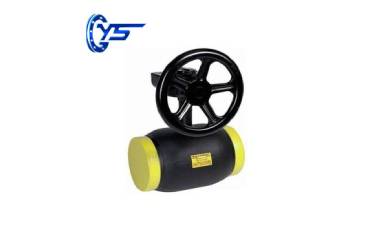Type of welding
01 Electrode arc welding
02 Submerged arc welding (automatic welding)
03 Carbon dioxide gas shielded welding (automatic or semi-automatic welding)
04MIG/MAG welding (Melting inert gas shielded welding
05TIG welding (tungsten inert gas shielded welding)
06 Plasma arc welding has six welding methods. The principle and application of each method are different. Because it is not the focus of this article, you can simply know it.
Focus on the treatment of welding ball valve welding technology
The welding of Full Welded Ball Valve is actually different from ordinary welding technology because there are non-metallic sealing materials rubber and PTFE plastic in the valve cavity, which cannot be heat treated after welding. The thick-wall multi-layer welding process of the welded ball valve is a process of repeated heating and cooling of metal materials. Usually, its welded joints are designed to be narrow-gap thick-wall submerged arc welding, and most of them usefully welded valve bodies. It is the kind of super thick cylindrical welded joint.
Therefore, the stress concentration in the root gap of the valve body welded joint, residual stress and organization deterioration have become weak links in the valve body structure. The current two treatment methods are:
1
Heat treatment technology treatment
2
Treatment at the joints; these two treatments will produce stress concentrations several times the normal working stress, which also makes it difficult for manufacturers' engineers to deal with.
It can be seen that how to solve the stress concentration, residual stress, and structural deterioration of the root gap of the welded ball valve body welded joint has become the biggest problem of valve welding. Here is a summary of the main technical points of the valve body welding process as follows, hoping to help friends who want to know about ball valve welding technology!

Full Welded Ball Valve
Introduction of valve body welding process
1 Technical requirements of the valve body
The valve body has no deformation after seam welding, including upper and lower shaft flanges (45 steel).
The heating area of the valve body cannot be too wide and the temperature cannot be too high, otherwise the sealing device in the valve body will be damaged.
No weld bead should appear.
Ensure that the pressure is above 10MPa.
2 Weld structure
According to the above technical requirements, the weld is determined to be a non-penetration weld. Therefore, the butt joint form of the weld is required to ensure both assembly and non-penetration. After testing, the weld form was finally determined.
3 Valve body material
Because the valve body is ZG15Ⅱ, the chemical composition of the valve body was tested before processing, and the test results were consistent with the test results during casting, which met the design requirements.
4 Assembly
Use a hydraulic press to modify the flip tire positioning, and fasten the surrounding two halves with bolts, adjust and conduct a tightness test, and the outside of the sphere and the valve body meet the design requirements.
5 welding process
Taking into account the technical requirements of the valve body, the MAG's CO2 welding machine was finally selected.
The welding material is ER50-6 (Ø1.0) welding wire.
According to the principle of equal strength of welding materials, the selected ER50-6 (Ø1.0) welding wire meets the requirements of ZG15Ⅱ.
The shielding gas is a mixture of 82%Ar+18%CO2.
5.1
Due to the serious hardening tendency of cast steel and 45 steel, it needs to be preheated before tack welding. The oxygen-acetylene flame is used to uniformly heat to 75~100℃ in the range of two times the thickness of the plate on both sides of the weld. (Deflection to the 45 steel side), subject to not affecting the sealing device, measured with a far-infrared thermometer.
Before welding, the oxide scale and rust on both sides of the weld are polished with an angle grinder to give a metallic luster.
Mark 6 positioning points 50mm from the edge on both sides of the weld, and measure the distance between the two points with a caliper to measure the shrinkage.
5.2
Small welding parameters should be adopted in the selection of welding specifications, that is, small welding heat input. Under the premise of ensuring the quality of the weld, try to increase the welding speed and reduce the fusion ratio. In terms of deformation, adopt the method of multi-layer and multi-channel symmetrical welding in 6 sections; pay attention to measuring the positioning point with a caliper for each welding layer, and measure the shrinkage Control until the welding is completed. Except for the first and last lanes, the hammering method is used for stress relief between the other lanes.
6 last
After the welding is completed, there is no leakage through the pressure test (air tightness) of the weld joint, and after the sealing surface meets the technical requirements, through X-ray inspection, the weld itself has no welding defects such as porosity, slag inclusion, non-fusion, cracks, etc. The valve core rotation meets the technology Claim.
We are a gate valve manufacturer, if you are interested in our products, please feel free to contact us.
Previous: Summary of Butterfly Valve Knowledge
Copyright © Hebei Yaosheng IM & EX Trading Co.,Ltd. All Rights Reserved |Sitemap | Technical Support: 
